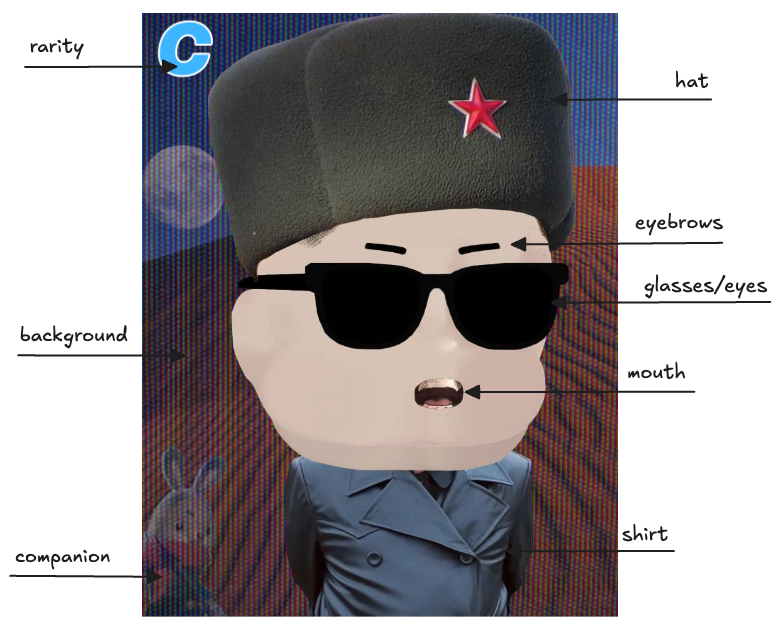NFT Overview
Lazarus is an NFT series constructed from Milady-adjacent design principles, North Korean political aesthetics, and elements of early 2000s tech culture. The selection of Lazarus and Kim Jong Un is deliberate; North Korea's consistent preference for Ethereum in state-sponsored cyber operations positions them among the earliest de facto ETH maxis. Following Base's stated objective to onboard every global currency in 2024 — and the broader claim that “Base is for everyone” — Lazarus extends that logic to its inevitable conclusion by bringing the North Korean Won (KPW) on-chain. Each Lazarus NFT is designed to be worn — not as passive decoration, but as active visual alignment. Meme coins collapse without aesthetic cohesion; Lazarus provides the signal. If you mint one, you wear it.

Rarity: The rarity is structured, not ornamental. NFTs are minted across six probability classes, each tied to a multiplier that decides your token emissions. Rarity impacts token flow directly — not cosmetic status. Minting is closer to gacha than gallery; rarity determines how many of the tokens you receive.
Background: The backgrounds span a curated range of imagery, pulling from North Korean propaganda art, fictionalized American suburban warzones like Call of Duty’s "Nuketown," and distorted variants of Microsoft's Bliss — the most recognized desktop background in history. Additional layers include North Korea’s national flags, maps of the Hermit Kingdom, and archival-style depictions of Kim Jong Un posing with military-grade weaponry. The result is a collision between isolationist nationalism, consumer escapism, and digital myth-making.
Companion: Each NFT includes a "companion" — a secondary embedded figure or symbol placed intentionally within the frame to add narrative depth and provoke interpretation. Companions range from Kim Yo Jong, Kim Jong Il, and Kim Il Sung, to the Lazarus Group insignia, characters from North Korean children's propaganda shows, Donald Trump, Vladimir Putin, and depictions of nuclear armament. They are not decorative additions; they function as deliberate intrusions into the visual field, forcing a negotiation between legacy power structures, ideological mythology, and the mechanics of digital attention.
Hats: The hats featured in the collection are directly sourced from archival imagery of Kim Jong Un. Each hat has been meticulously extracted and reconstructed to fit the proportions and design of Lazarus, preserving their original context while adapting them to a new visual framework. The intent is not parody, but the recontextualization of political iconography within an emergent digital medium.
Eyebrows: Eyebrow variations across the collection are intentionally designed to evoke different emotional undercurrents. Minor shifts in brow angle and thickness create expressions ranging from detached neutrality to subdued aggression or restrained amusement. These subtle manipulations allow for differentiated psychological readings without disrupting the formal structure of Lazarus.
Glasses/Eyes: Eyewear was designed to remain clean and restrained, aligning with depictions of the Supreme Leader, who is often photographed wearing either designer eyeglasses or darkened sunglasses. Glasses are used to preserve the sense of distance and authority embedded in the character’s cultural mythos. Eye variations, by contrast, are employed to surface different emotional states across the collection — from stoicism and exhaustion to muted amusement and restrained elation — allowing each Lazarus to project a distinct internal narrative while remaining within the controlled structure of the series.
Mouth: Mouth variations were designed to span a wide emotional and symbolic range. Traditional expressions — stoicism, disdain, amusement — are positioned alongside hypermodern intrusions such as titanium teeth, referencing Ye’s adoption of post-human dental aesthetics. The goal is to disrupt the uniformity of expression without undermining the structural consistency of Lazarus, bridging classical emotional cues with contemporary signals of transformation and excess.
Shirt: Shirt and jacket variations are sourced directly from archival imagery of Kim Jong Un, widely regarded as the most fashion-conscious autocrat in modern history. Multiple Mao suits, military uniforms, and civilian jackets were meticulously extracted, reconstructed, and adapted to fit the proportions of Lazarus, ensuring PFP viability without compromising historical reference. The wardrobe reflects a continuum of control aesthetics — from revolutionary tradition to contemporary authoritarian pageantry — embedded within the broader mythos of the character.
Tokenomics
The total supply of KPW is fixed at 1,000,000,000 tokens. In keeping with its namesake, KPW is positioned as a "stablecoin" — though only in the most conceptual sense. 95% of all primary mint proceeds are allocated directly to the liquidity pool, paired at 10,000 Lazarus to 0.003 ETH, establishing an initial liquidity depth of approximately 28.5 ETH against the KPW base. No additional team allocation, reserves, or emissions exist beyond what is minted and paired at launch. The system is designed to be permissionless, unstable, and entirely reflective of attention dynamics.
Utility & Mechanics
Lazarus NFTs have no utility in the conventional sense. There are no hidden mechanics, staking systems, or interactive features. Each NFT serves two explicit purposes: as an emissions mechanism for KPW distribution, and as a profile picture to signal unwavering support for the Great Leader. The design is intentional — value accrues not through functionality, but through visual alignment and attention anchoring.
Lore / Culture
Lazarus exists at the intersection of authoritarian myth-building, early internet visual optimism, and decentralized narrative collapse. It reframes legacy power symbols — from North Korean propaganda to suburban Americana — through the lens of meme-driven attention economies. Kim Jong Un remains one of the most consistent attention generators on the global stage, an unignorable figure in a system designed to reward spectacle. When Base announced its goal of onboarding every global currency, it was obvious KPW was not part of the invitation — which is precisely why Lazarus exists. Culturally, Lazarus draws from the contradictions of the real-world Lazarus Group: a hacker collective both dependent on crypto and destructive to it. Wearing Lazarus is not participation in a community; it is submission to the idea that attention, not governance, defines modern legitimacy.